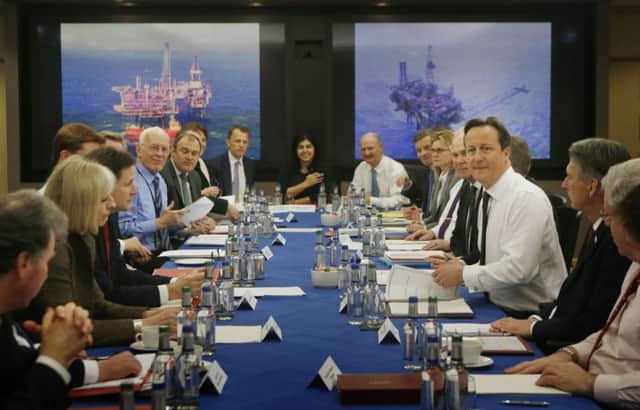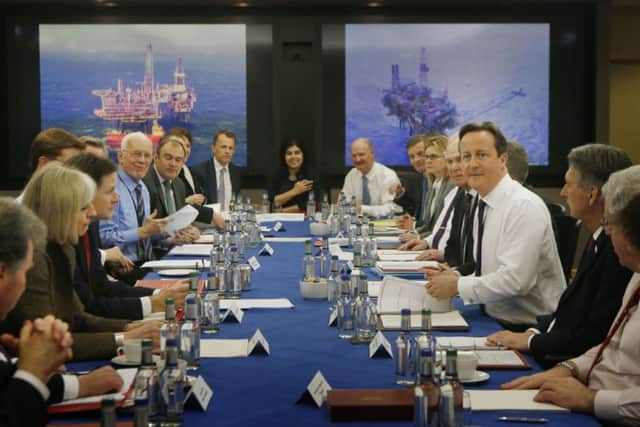Scottish independence: Plan B to keep using pound


The First Minister insisted there was “not a question” about keeping the pound, but only whether a formal monetary union – so far ruled out – could be secured with Westminster.
Aberdeen yesterday became the latest battleground in the referendum campaign, with ministers from both the Scottish and UK governments carrying out a series of engagements around the North-east as the key issues over independence came under the spotlight. But the two leaders did not meet despite being just seven miles apart.
Advertisement
Hide AdAdvertisement
Hide AdPrime Minister David Cameron revealed that he would not block an independent Scotland joining the EU, prompting claims that he would climb down over his warning that, if in power, he would block Scotland from sharing the pound. Chancellor George Osborne warned a fortnight ago that an independent Scotland could not share the UK pound in a currency union which would have seen the Bank of England remaining as a “lender of last resort”, ready to bail out the fledgling state.


The SNP leadership has refused to be drawn on its preferred alternative on the currency issue, insisting that Westminster is bluffing on the issue.
The First Minister said yesterday: “It’s bluster because George Osborne expressed [the argument] as about keeping the pound.
“Of course the pound is an internationally tradable currency. It’s not a question of keeping the pound, it’s a question of whether there would be agreed a currency union. That’s the bluster aspect.”
A spokesman for the First Minister yesterday said the his comments were a “statement of fact”, adding: “There’s absolutely nothing anyone can do – George Osborne or David Cameron – or anyone else to stop Scotland using the pound. The pound is as much Scotland’s currency as anyone else’s.”
But the policy of the Scottish Government remains for a formal currency union. If the pound was to be used informally, it would be a similar arrangement to Panama which uses the US dollar or Montenegro – which is not part of the eurozone – using the euro.
UK Treasury Secretary Danny Alexander warned that major banks could quit Scotland under such an arrangement.
“It’s a dramatic shift,” he said. “Alex Salmond has set out a Plan B where Scotland wouldn’t have control over interest rates. It would put hundreds of thousands of jobs at risk.
Advertisement
Hide AdAdvertisement
Hide Ad“We have that [strong financial sector] because we have access to the Bank of England as the lender of last resort. It’s hard to see how major financial institutions would remain here if there is no Bank of England and lender of last resort.”
The Prime Minister defended the UK government’s decision to rule out a currency union.
“It would be an extraordinary referendum campaign if the Scottish people weren’t told in advance of that referendum what the consequences of separation are,” said Mr Cameron.
“There are risks to separation, and it’s right that those are properly, calmly and reasonable laid out.”
But Mr Cameron indicated he would “absolutely” support Scotland’s EU membership, despite warnings that Scotland would struggle to rejoin the EU after independence.
Deputy First Minister Nicola Sturgeon said this showed that, under questioning, the Prime Minister “climbs down from a position of scaremongering to a position of common-sense”.
She added: “He would support Scotland’s membership of the EU just as when it comes to it he will back the continuing sharing of currency.”
On a day of verbal sparing, Westminster MPs were branded “thieves” by Mr Salmond as he held a Scottish Cabinet meeting in Portlethen, just outside the Granite City. But the First Minister was accused of turning families against each other by senior UK Cabinet ministers as they met in the city.
Advertisement
Hide AdAdvertisement
Hide AdThe North-east came to the fore as a report by oil and gas services magnate Sir Ian Wood was published. It set out measures to generate £200 billion for the British economy by ensuring up to four billion extra barrels are recovered from the North Sea over the next 20 years.
A raft of major announcements were made, including a £100 million carbon capture and storage (CCS) project for the North-east town of Peterhead by Mr Cameron. A new £10.6m oil and gas innovation centre was announced by Mr Salmond.
The Prime Minister insisted that the North Sea oil and gas industry is better supported by the UK economy than it would be under independence.
“It’s more important than ever that the North Sea oil and gas industry has the backing of the whole of the United Kingdom, it has the deep pockets and the broad shoulders of the UK economy to make sure we can go on benefiting from this for many years to come,” said Mr Cameron.
He rejected suggestions that Scotland or the UK should have set up a Norway-style oil fund.
“We see that North Sea revenues have built schools and hospitals and roads and railways,” he said.
“Here in Scotland they’ve sustained a level of spending per head that is ahead of that of the rest of the United Kingdom.”
But Mr Salmond later highlighted Norway as an example of a small country with a successful oil industry.
Advertisement
Hide AdAdvertisement
Hide AdWith a population of around five million, it is of similar size to Scotland, but he claimed it had handled its oil and gas resources “better than the stewardship of Westminster, as Norway has accumulated much of its revenues for a futures fund for future generations”.
The Scottish Government has put forward plans to establish two oil funds if there is a Yes vote in September’s referendum – one short-term fund to help deal with fluctuations in oil and gas revenues, alongside a long-term savings fund.
Education Secretary Michael Gove, who was brought up in Aberdeen, said: “Alex Salmond may present himself as father figure of the nation, but he actually wants to set brother against sister.”
SKETCH
Andrew Whitaker: Best of time and worst of times with a tale of two Cabinets but just one city
IT WAS a day when the hand of history pointed directly at Aberdeen, with David Cameron taking a UK Cabinet meeting to the Granite City for the first time in nearly a century.
The last prime minister to bring his cabinet to Scotland’s third-biggest city was David Lloyd George, who was also the premier who presided over the vote for Irish independence from the UK back in 1922.
Lloyd George made his visit to Aberdeen with his cabinet back in 1921 – a year before the creation of the new Irish Free State. Mr Cameron, anxious not to be the Prime Minister who loses Scotland, was in Aberdeen while his nationalist rival Alex Salmond took his own cabinet to the town of Portlethen just south of Aberdeen – little over seven miles away from each other.
With high-ranking ministers from Westminster and Holyrood out and about on the streets of the North-east, it was very much a tale of two Cabinets, with two starkly contrasting approaches from two starkly different leaders.
Advertisement
Hide AdAdvertisement
Hide AdWhile Alex Salmond’s met in a parish church in Portlethen, with a public Q&A at the same venue, Mr Cameron’s team were holed up in the corporate HQ of Shell, one of the world’s biggest energy companies.
The two contrasting approaches will have suited Mr Salmond down to the ground as UK Cabinet heavyweights took part in a series of heavily choreographed visits to executives from Aberdeen’s energy giants, the city’s airport as well as a school once attended by Tory Education Secretary Michael Gove.
Strikingly, very few details of visits by UK Cabinet ministers were made public until the 11th hour, with officials possibly fearful of protest resembling the now infamous scrum when Ukip leader Nigel Farage travelled to Edinburgh last year.
It was almost as if a concerted effort was made to keep Tory ministers away from the good folk of Aberdeen – a city that has not elected a Tory MP in more than 20 years, despite having once been a bastion of support for the party.
The near-clandestine visit, with Mr Cameron carefully shielded from the press pack, contrasted starkly with that of Mr Salmond, who was his usual large-as-life self in his own backyard of Aberdeenshire – where he was first elected as an MP in 1987.
But the historical significance of having two Cabinets effectively in the same city on the same day illustrate how the campaign is getting serious, even if the two camps were kept apart like rival football fans in a particularly explosive cup tie.
SEE ALSO